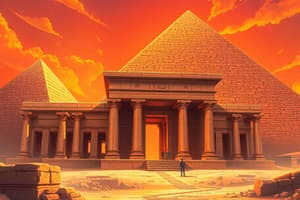Podcast
Questions and Answers
What is the primary design goal of Egyptian architecture as stated in the content?
What is the primary design goal of Egyptian architecture as stated in the content?
- Use of colorful materials
- Height and elevation
- Intricate decorations
- Internal effect (correct)
Which of the following describes the 'Mastaba'?
Which of the following describes the 'Mastaba'?
- A large open-air temple
- A simple mud brick tomb (correct)
- An elaborate palace structure
- A ceremonial site for gods
What is a distinguishing feature of the walls of a Mastaba?
What is a distinguishing feature of the walls of a Mastaba?
- Flat and battered (correct)
- Vertical and rough
- Smooth and circular
- Curved and decorated
Which type of pyramid is recognized as the world's first large-scale stone monument?
Which type of pyramid is recognized as the world's first large-scale stone monument?
What characterized the Bent Pyramid's construction?
What characterized the Bent Pyramid's construction?
Which pyramid is considered the oldest and largest in the Giza Complex?
Which pyramid is considered the oldest and largest in the Giza Complex?
What is the name of the upright stone slab that contains the name of the deceased?
What is the name of the upright stone slab that contains the name of the deceased?
What is a significant architectural feature of the true/sloped pyramids?
What is a significant architectural feature of the true/sloped pyramids?
What is the purpose of a mortuary temple?
What is the purpose of a mortuary temple?
Which pyramid is the smallest and was the last to be built at Giza?
Which pyramid is the smallest and was the last to be built at Giza?
What distinguishes corridor tombs from other types of rock-cut tombs?
What distinguishes corridor tombs from other types of rock-cut tombs?
What is the function of the pyramid causeway?
What is the function of the pyramid causeway?
Which statement about obelisks is correct?
Which statement about obelisks is correct?
What is a key characteristic of hillside tombs?
What is a key characteristic of hillside tombs?
What is the function of a valley temple?
What is the function of a valley temple?
What structure is known as the uppermost piece or capstone of a pyramid or obelisk?
What structure is known as the uppermost piece or capstone of a pyramid or obelisk?
What material is ELECTRUM primarily made of?
What material is ELECTRUM primarily made of?
Which obelisk was originally located in Heliopolis?
Which obelisk was originally located in Heliopolis?
Who commissioned the Luxor Obelisk in Paris?
Who commissioned the Luxor Obelisk in Paris?
What is a CRIOSPHINX characterized by?
What is a CRIOSPHINX characterized by?
What is the primary function of the Sanctuary in a temple?
What is the primary function of the Sanctuary in a temple?
Which temple was dedicated to the goddess of music and love?
Which temple was dedicated to the goddess of music and love?
What architectural feature defines a HYPOSTYLE HALL?
What architectural feature defines a HYPOSTYLE HALL?
Which pharaoh is associated with the construction of the Colossi of Memnon?
Which pharaoh is associated with the construction of the Colossi of Memnon?
What was the primary purpose of the BARQUE CHAPEL?
What was the primary purpose of the BARQUE CHAPEL?
What is significant about the GREAT HYPOSTYLE HALL?
What is significant about the GREAT HYPOSTYLE HALL?
Flashcards are hidden until you start studying
Study Notes
Egyptian Architecture Overview
- Egyptian architecture focuses on internal effects, characterized by simplicity, monumentality, and massiveness.
Religious Structures
Mastaba
- Named from Arabic, meaning "bench of mud," serves as a tomb for nobility.
- Features include burial chambers accessed via a shaft leading to offering chambers.
- Constructed from mud with a rectangular plan, flat roof, and battered walls.
- Key components: stone facing, outer chambers (sacrificial chapel), serdab (housing statues of the deceased), and masonry seal.
Pyramids
- Developed from the mastaba design and consists of massive masonry structures.
- Constructed using stone with smooth, steeply sloping sides converging at an apex, oriented to cardinal points.
- Types of pyramids:
- Step Pyramid: Earliest form, example is Djoser’s pyramid designed by Imhotep, standing 254 ft tall.
- Bent Pyramid: Example is Sneferu’s pyramid; features two angles due to collapse during construction.
- True Pyramids: Characterized by four smooth triangular sides; example includes the Red Pyramid built by Sneferu.
- Giza Pyramid Complex: Comprises three major pyramids:
- Khufu (Cheops): Oldest and largest, architect Hemiunu, one of the Seven Wonders.
- Khafre (Chephren): Guarded by the Great Sphinx.
- Menkaure: Smallest of the three.
Giza Pyramid Complex
- Ceremonial area surrounding the pyramids includes parts such as:
- Mortuary Temple: For worship of deceased royalty.
- Pyramid Temple: Specifically connected to a pyramid.
- Valley Temple: Used for the pharaoh’s preparations for the afterlife.
Rock-Cut Tombs
- Tombs hewn out of stone, supported by pillars.
- Types include:
- Hillside Tombs: For nobility, e.g., Hasan Tombs, featuring an offering chapel.
- Corridor Tombs: Exclusive to pharaohs, exemplified by the Valley of the Kings.
Temples
- Designed for worship, divided into:
- Cult Temples: For mysterious ancient deities.
- Mortuary Temples: For deified pharaohs.
Temple Components
- Phylon: Monumental gateway with obelisks and a sphinx avenue.
- Obelisk: Tapering four-sided shaft, seen as a sacred symbol; examples include Vatican Obelisk and Lateran Obelisk.
- Avenue of Sphinxes: Leading to temple portals.
- Hypaethral Court: Open-roofed court with colonnades.
- Hypostyle Hall: Large hall with columns supporting a flat roof and possible clerestory.
- Sanctuary: Holiest area, reserved for priests and pharaohs.
Notable Temples
- Great Temple of Abu Simbel: Built by Rameses II, featuring colossal statues.
- Temple of Hathor and Nefertari: Dedicated to Rameses' wife and the goddess Hathor.
- Karnak Temple Complex: Encompassing the Temple of Amun Ra, known for its grandeur and the Great Hypostyle Hall.
Architectural Features
- Capital, columns, and moldings include unique designs such as Osiris pillars and Khekher moldings which are foundational elements in ancient Egyptian structures.
Studying That Suits You
Use AI to generate personalized quizzes and flashcards to suit your learning preferences.




